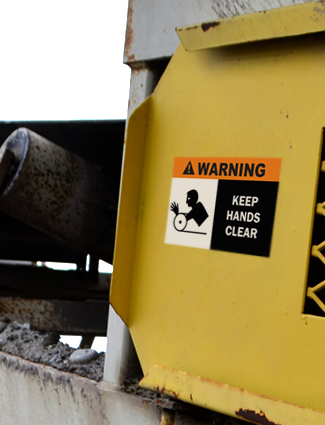Signs That Stick: The Importance of Industrial Grade Label Adhesives

Considering the Chemistry of Surface Adhesion
The International Union of Pure and Applied Chemistry (IUPAC), a scientific organization that seeks to advance the chemical sciences, defines adhesion as the process of attachment of a substance to the surface of another substance and notes that adhesion requires energy that can come from chemical or physical linkages.
 The forces responsible for the "sticky" character of decals, stickers, and industrial tape often rely on chemical adhesion to bond to a variety of surfaces. That stickiness plays an important role; when safety signs and labels are placed on rough, uneven surfaces, it's essential that signage stands up to the rigors of an industrial workplace. Choosing a tape with the wrong adhesive can mean the difference between a safe workplace and catastrophic accidents.
The forces responsible for the "sticky" character of decals, stickers, and industrial tape often rely on chemical adhesion to bond to a variety of surfaces. That stickiness plays an important role; when safety signs and labels are placed on rough, uneven surfaces, it's essential that signage stands up to the rigors of an industrial workplace. Choosing a tape with the wrong adhesive can mean the difference between a safe workplace and catastrophic accidents.
A chemical adhesion happens when the surface atoms of two separate surfaces form a bond; accordingly, the role of an adhesive is to bind and resist separation over time-and to withstand environmental changes.
A key factor influencing the effectiveness of the adhesive to bond is referred to as surface energy. Every surface that is to be labeled (metal, concrete, wood) will exhibit a different surface energy that contributes to how well an adhesive will stick. You can see low surface energy (LSE) in action as water tends to separate and bead up on the surface of a freshly waxed car. A high surface energy (HSE) condition will exhibit more wettability as water or the adhesive of a high-quality industrial label will tend to flow or "wet-out" in order to assure a stronger bond.
Temperature is another factor that influences the energies in play. Pipes, tanks, and surfaces covering motors may emit heat that can degrade adhesion. The porosity and roughness of a surface also determine how well labels and tapes will adhere-and for how long.
Accounting for Surface Types in the Workplace
Many companies in the metal product manufacturing, food processing, mining, and utility sectors have workplaces with surfaces that are difficult to label with non-industrial adhesive labels and tapes. Equipment, pipes, flooring, and walls are often uneven, textured, flexible, or contaminated with grease and dirt.

A facility safety audit conducted by a safety or lean manufacturing expert will often result with a list of recommendations to improve the visibility of safety or workflow best practices of the physical workspaces. Examples often include visual upgrades to:
- Metal or plastic piping to show contents and flow direction
- Painted metal drums to indicate hazardous contents
- Equipment operation and hazard warnings for surfaces that are exposed to oil, gas, or moisture
- Concrete or brick walls and floors to note permit-required confined spaces
- Painted metal or wood storage areas for inventory management
- Photovoltaic panel frames that must resist UV light
The challenge for the facility manager is to determine what sorts of labels will adhere to surfaces that by their nature have low surface energy, are textured, or prevent adhesion due to contaminants.
Most clean metal surfaces (aluminum, copper, and zinc) will have a high surface energy which is good for initial label adhesion. However, it's important to note that some adhesive formulas can eventually corrode stainless steel, so low-halogen formulated adhesives should be used. Plastics and paint coatings tend to have a wider variety of surface energy characteristics. For example, rigid PVC or epoxy paint would fall into the HSE category while and EVA, polystyrene, or powder coated surface may exhibit very low surface energy.
Industrial signs, labels, and tapes address these needs with special adhesives and conformable vinyl or polyester films that will adhere to almost anything and are impact- and chemical-resistant to survive harsh workplace environments.
Resources for Labels with Special Adhesion Properties
Not all surfaces are created equal. Labels with special adhesion properties like DuraLabel Special Adhesive tapes can successfully adhere to low surface energy and textured surfaces such as plastics, concrete, and wood. This type of adhesive is made with extra strength and thickness to firmly hold to complex surfaces for years of use in both indoor and outdoor settings.
|
DuraLabel Special Adhesive Labeling Products |
Features |
|
Color: Satin white |
|
|
Color: Available in several colors |
|
|
Color: White |
|
|
Color: White |
|
|
Color: White |
Related Resources

Product Identification
Product identification is a broad category of labeling that includes functions such as product traceability, ...
Read
DIY Labels or Premium Label Supply? Choosing the Right Safety Signs
Should Your Facility Use Premium Vinyl Labels or DIY Label Solutions? Labels play a critical role in ...
Read
Why Upgrade to the DuraLabel Toro Max Industrial Sign and Label System
What are the Key Benefits of Upgrading to the DuraLabel Toro Max Industrial Label Printer? In demanding ...
Read.png)





